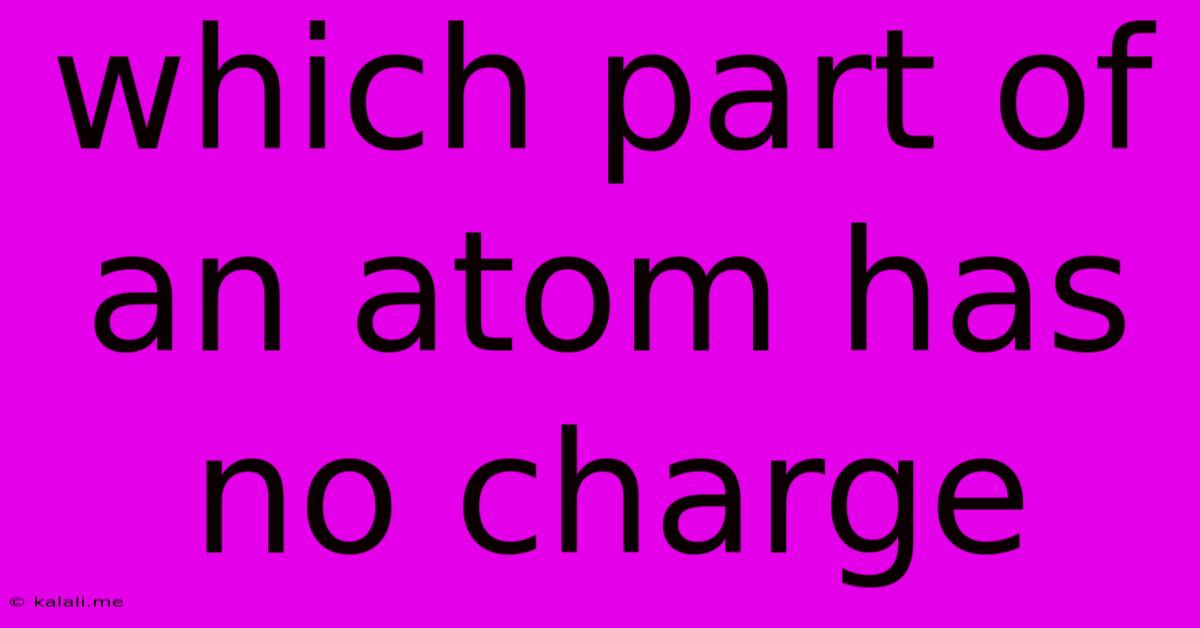Which Part Of An Atom Has No Charge
Kalali
Jun 13, 2025 · 3 min read

Table of Contents
Which Part of an Atom Has No Charge? Understanding Neutrons
Have you ever wondered what makes up the tiny building blocks of matter? Atoms, the fundamental units of elements, are composed of three primary particles: protons, electrons, and neutrons. While protons carry a positive charge and electrons carry a negative charge, the answer to the question "Which part of an atom has no charge?" is the neutron. This seemingly simple answer opens up a fascinating world of subatomic physics and its implications.
This article will delve deeper into the nature of neutrons, their role within the atom, and their significance in various scientific fields. We'll explore their mass, their discovery, and their importance in nuclear reactions.
What are Neutrons?
Neutrons are subatomic particles found in the nucleus of an atom, alongside protons. Unlike protons and electrons, neutrons possess no electrical charge, hence their name. They are slightly heavier than protons, contributing significantly to an atom's mass. This mass, combined with the protons, determines the atomic mass number of the element.
The number of neutrons in an atom's nucleus can vary, even within the same element. These variations are called isotopes. Isotopes of an element have the same number of protons but differ in the number of neutrons. Some isotopes are stable, while others are radioactive and decay over time.
The Discovery of Neutrons
The discovery of the neutron marked a pivotal moment in the understanding of atomic structure. Before its discovery, scientists struggled to reconcile the observed atomic mass with the number of protons, which were believed to be the only particles in the nucleus. James Chadwick, a British physicist, is credited with the discovery of the neutron in 1932. His experiments involved bombarding beryllium with alpha particles, resulting in the emission of a neutral particle that could knock protons out of paraffin wax. This demonstrated the existence of a neutral particle within the atom's nucleus – the neutron.
The Role of Neutrons in Nuclear Reactions
Neutrons play a crucial role in various nuclear processes. Their lack of charge allows them to penetrate atomic nuclei relatively easily, initiating nuclear reactions such as nuclear fission and nuclear fusion.
-
Nuclear Fission: In fission, a heavy atomic nucleus, like uranium, splits into smaller nuclei when bombarded by neutrons. This process releases a tremendous amount of energy, utilized in nuclear power plants and nuclear weapons.
-
Nuclear Fusion: In fusion, light atomic nuclei, such as hydrogen isotopes (deuterium and tritium), combine to form a heavier nucleus, like helium. This process also releases a vast amount of energy, powering the sun and stars.
Neutrons and Isotopes: A Closer Look
As mentioned earlier, isotopes are variations of an element with differing numbers of neutrons. This difference in neutron count can significantly impact an isotope's stability and properties. Some isotopes are stable, meaning they don't decay spontaneously, while others are radioactive, undergoing decay processes that emit particles and energy. Radioactive isotopes have various applications in medicine, research, and industrial processes.
Understanding isotopes is crucial in various scientific fields, from nuclear physics and chemistry to medicine and environmental science. The behavior and properties of different isotopes are critical to understanding the processes occurring at the atomic level.
In conclusion, the part of an atom with no charge is the neutron. This seemingly simple particle plays a fundamental role in the structure and behavior of atoms, driving nuclear reactions and shaping the properties of isotopes. The discovery of the neutron revolutionized our understanding of the atom, leading to numerous advancements in science and technology.
Latest Posts
Latest Posts
-
Operant Conditioning Is Also Known As
Jun 14, 2025
-
Columbia University New York Gpa Requirements
Jun 14, 2025
-
Bronze Is A Mixture Of What
Jun 14, 2025
-
Speed Of Light In Terms Of Mu And Epsilon
Jun 14, 2025
-
Which Of The Following Is A Function Of The Skeleton
Jun 14, 2025
Related Post
Thank you for visiting our website which covers about Which Part Of An Atom Has No Charge . We hope the information provided has been useful to you. Feel free to contact us if you have any questions or need further assistance. See you next time and don't miss to bookmark.